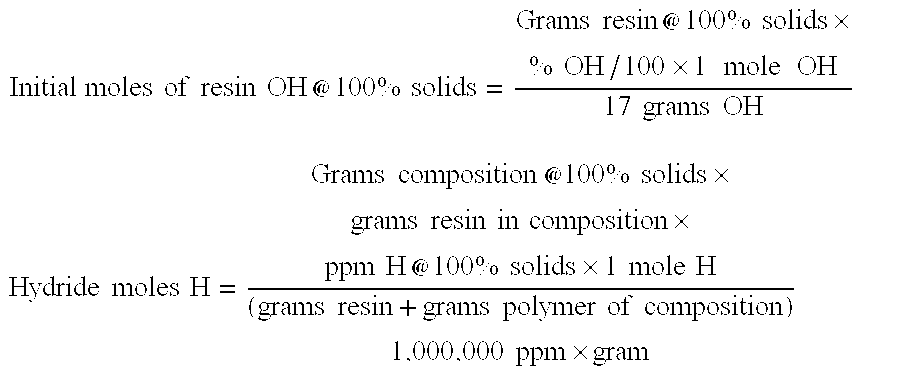Self-crosslinking Silicone Pressure Sensitive Adhesive Compositions, Process For Making and Articles Made Thereof
a technology of pressure sensitive adhesives and compositions, applied in the direction of adhesives, etc., can solve the problems of unpredictable crosslinking, affecting the optical clarity of adhesives, and unsuitable peroxide curable psas for electronic display construction
- Summary
- Abstract
- Description
- Claims
- Application Information
AI Technical Summary
Benefits of technology
Problems solved by technology
Method used
Image
Examples
example 1
[0074]This example illustrates a two step process to prepare addition curable PSA. In the process, the silanol MQ resin is functionalized to a silanol-silicon hydride functional MQ resin first, then the functionalized MQ resin is reacted with vinyl-functional polyorganosiloxane to produce the PSA.
[0075]A. Silanol-Silicon Hydride Functional MQ Resin Preparation
[0076]353.4 g of MQ resin, M / Q=0.7 and 2.70 wt % OH (0.3401 moles OH), as a 60.6 wt % solids in toluene was added to a reaction vessel under nitrogen atmosphere. With agitation 24.1 g of a 20-wt % 1,1,3,3-tetramethyldisilazane in toluene solution was slowly added. After one-hour agitation Si29 NMR analysis of a sample showed 0.82 / 0.03 / 1.00 for M / MH / QOH for the silanol-silicon hydride resin at 100% solids resin. Hydride at 100% solids was 307 ppm using a gasometrical method. Using the above calculation method the silanol-silicon hydride resin had 0.2744 moles OH (80.7 mole %) and 0.0658 moles H (19.3 mole % H).
[0077]B. Pressure ...
example 2
[0090]Example 2 illustrates the process to prepare addition cureable PSA from in-situ functionalized MQ resin.
[0091]To a 1-liter reactor was charged 150.0 g MViDVi3D6600MVi (100 wt % of polyoragnosiloxane polymer), 325 g of a 10.4 cstks. 60% toluene solution MQ resin, M / Q=0.7 and 2.70 wt % OH (0.3097 moles OH), and 150.0 g toluene. Resin to polymer ratio was 1.30. The mixture was reflux dried then 10.0 g of a 20-wt % toluene solution of 1,1,3,3-tetramethyldisilazane was slowly added and agitated for 2 hours at room temperature. After agitation for an additional 1 hour at room temperature, the mixture was refluxed for one hour, excess base neutralized with phosphoric acid to 0-10 ppm as acid, then excess toluene was removed, then resulting composition was cooled to room temperature. The adhesive composition viscosity was 408,000 cps, 70.8% solid at 25° C., and 23 ppm hydride on a 100% solids basis by a gasometrical method determined. Using the above calculation method the silanol-sil...
example 3
[0095]To a 1-liter reactor was charged 100.0 g MViDVi8D4100MVi (100 wt % of polyoragnosiloxane polymer), 220.0 g of a 10.4 cstks. 60% toluene solution MQ resin, M / Q=0.7 and 2.00 wt % OH (0.1553 moles OH), and 100.0 g toluene. Resin to polymer ratio was 1.32. The mixture was reflux dried, then 13.0 g of a 20 wt % toluene solution of 1,1,3,3-tetramethyldisilazane was slowly added and agitated for 2 hours at room temperature. After agitation for an additional 1 hour at room temperature, the mixture was refluxed for one hour. Excess base was neutralized with phosphoric acid to 0-10 ppm as acid, then excess toluene was removed, then the resulting composition was cooled to room temperature. The adhesive composition viscosity was 80,400 cps, 72.2% solid at 25° C., 39 ppm hydride on a 100% solids basis. Using the above calculation method the silanol-silicon hydride resin had 0.1501 moles OH (96.7 mole %) and 0.0051 moles H (3.3 mole % H) prior to refluxing. The SiH / Vi ratio was 4.9.
[0096]A ...
PUM
| Property | Measurement | Unit |
|---|---|---|
| Fraction | aaaaa | aaaaa |
| Percent by mass | aaaaa | aaaaa |
| Fraction | aaaaa | aaaaa |
Abstract
Description
Claims
Application Information
 Login to View More
Login to View More - R&D
- Intellectual Property
- Life Sciences
- Materials
- Tech Scout
- Unparalleled Data Quality
- Higher Quality Content
- 60% Fewer Hallucinations
Browse by: Latest US Patents, China's latest patents, Technical Efficacy Thesaurus, Application Domain, Technology Topic, Popular Technical Reports.
© 2025 PatSnap. All rights reserved.Legal|Privacy policy|Modern Slavery Act Transparency Statement|Sitemap|About US| Contact US: help@patsnap.com

